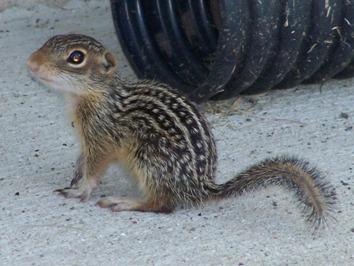Nutrition
Spermophilus tridecemlineatus is an omnivore consuming both
heterotrophs and autotrophs, in equal amounts. The animals
consumed include insects (grasshoppers being the squirrel's
favorite), their eggs, wireworms, ants, cutworms,
caterpillars, beetles,
earthworms, and carrion. Seeds,
especially
sunflower seeds,
nuts, grasses, clover, green shoots, flower heads, roots,
fruits, vegetables,
corn, wheat, and other cereal grains are the
vegetative foods the squirrel ingests. Drinking water is
not a necessity since most of the plants consumed are succulent
and the squirrel is able to manufacture its own water
metabolically.
Depending on the season and time of year, the diet of the
squirrel varies. In the spring, fresh grass is readily
available and is the dominant food source. The main
vegetative sources switch during the summer when fruit, nuts,
and crops are produced and abundant. Plant matter food is
hoarded through out their active months, to be consumed during
harsh weather. A supply of food is saved until spring to be
used after arousal from hibernation when food is scarce in
addition.
The squirrels carry seeds and grasses in their cheek pouches to
be taken back to their underground burrows where the food is
placed in a storage chamber. During
hibernation food is not usually
consumed and the main source of energy during this time period
is hydrolyzed lipids from stored adipose tissue.
Next: Reproduction